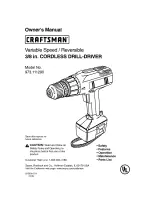
-15-
Before using an accessory,
be certain that its maximum
safe operating speed is not exceeded by the
nameplate speed of the tool. Do not exceed
the recommended wheel diameter.
SANDING AND POLISHING
Fine sanding and polishing re quire “touch”.
Select the most efficient speed.
When using polishing bonnets, always be sure
the excess string that secures the bonnet is
tucked well within the bonnet during operation.
WIRE BRUSHES
Work with brushes requires high speeds.
BRUSHING PRESSURE
1. Remember, the tips of a wire brush do the
work. Operate the brush with the lightest
pressure so only the tips of the wire come in
contact with the work.
2. If heavier pressures are used, the wires
will be overstressed, resulting in a wiping
action; and if this is continued, the life of the
brush will be shortened due to wire fatigue.
3. Apply the brush to the work in such a way
that as much of the brush face as possible is
in full contact with the work. Applying the
side or edge of the brush to the work will
result in wire breakage and shortened brush
life.
RUNNING NUTS AND BOLTS
Variable speed control must be used with
caution for driving nuts and bolts with socket
set attach ments. The technique is to start
slowly, increasing speed as the nut or bolt runs
down. Set the nut or bolt snugly by slowing the
drill to a stop. If this procedure is not followed,
the tool will have a tendency to torque or twist
in your hands when the nut or bolt seats.
CORRECT:
Wire tips doing the work.
INCORRECT:
Excessive pressure can cause wire breakage.
!
WARNING
When drilling holes in wood, twist bits can be
used. Twist bits may overheat unless pulled out
frequently to clear chips from flutes.
Use a “back-up” block of wood for work that is
likely to splinter, such as thin materials.
You will drill a cleaner hole if you ease up on
the pressure just before the bit breaks through
the wood. Then complete the hole from the
back side.
DRILLING METAL
There are two rules for drilling hard materials.
First, the harder the material, the greater the
pres sure you need to apply to the tool. Second,
the harder the material, the slower the speed.
Here are a couple of tips for drilling in metal.
Lubri cate the tip of the bit occasionally with
cutting oil except when drilling soft metals such
as alu minum, cop per or cast iron. If the hole to
be drilled is fairly large, drill a smaller hole first,
then enlarge to the required size, it’s often
faster in the long run. Main tain enough
pressure to assure that the bit does not just
spin in the hole. This will dull the bit and greatly
shorten its life.
BM 2610009564 10-09:BM 2610009564 10-09 10/7/09 7:20 AM Page 15
















































